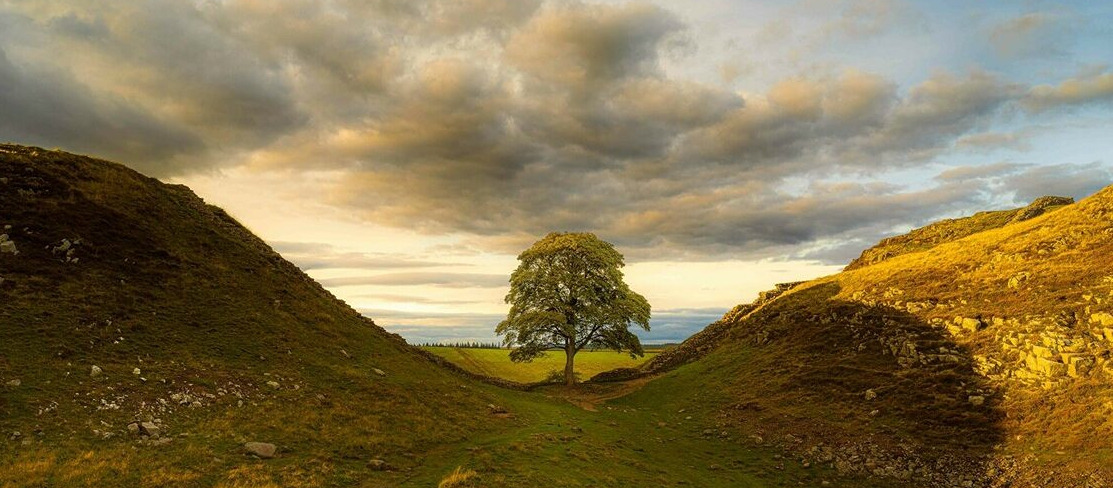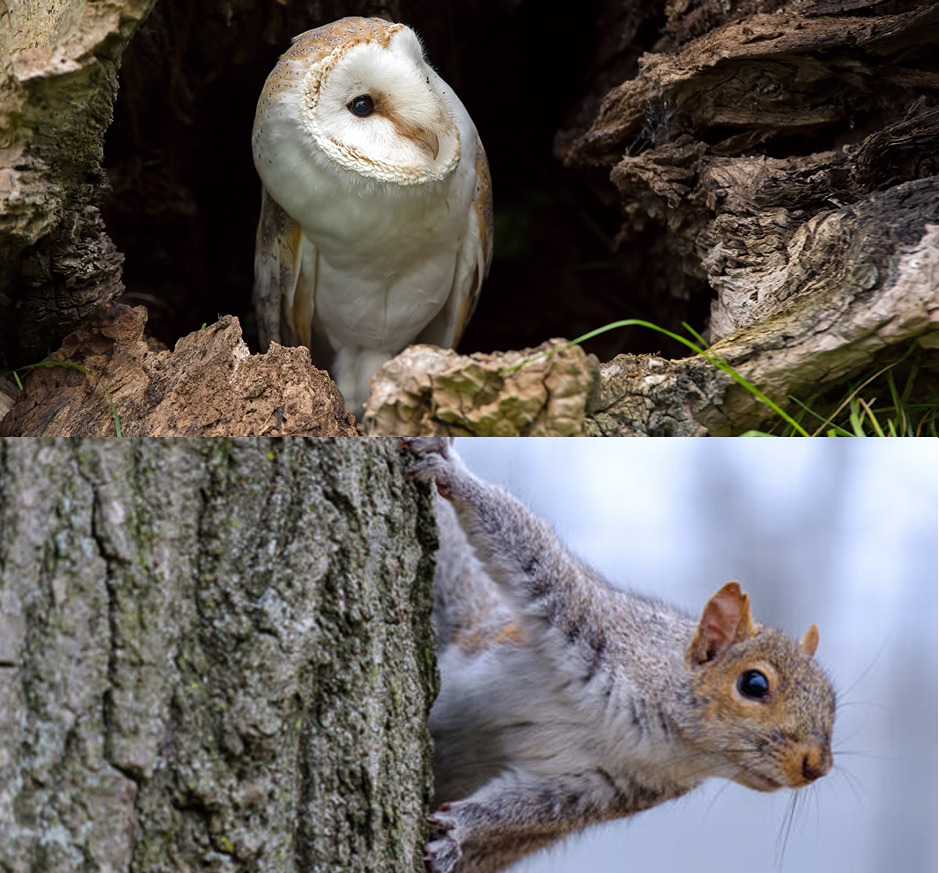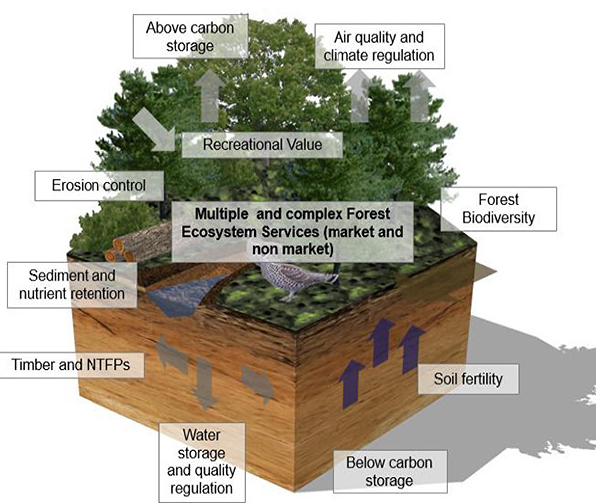The Importance of Trees
Scroll down for articles on TREES & WILDLIFE, TREES AND HEALTH & WELLBEING, BENEFITS OF URBAN TREES & ECOSYSTEM SERVICES
or click on links below to open on a new page:

Just how important trees are to us is indicated by the sense of loss caused by the felling of the 'Sycamore in the Gap'. But trees offer far more than landscape beauty: they also provide a vast array of environmental, social and economic benefits in both rural and urban areas across the UK and in the wide world.
Preserving and enhancing these benefits is crucial in addressing the climate crisis and combating biodiversity loss, yet although biodiversity, ecosystems, and the natural world are essential to our well-being and economic stability, they are often overlooked in traditional economic assessments and decision-making. When these decisions result in the permanent loss of tree cover, scant regard is given to the fragmentation of our already vulnerable natural environment, let alone the harmful effects on public health and well-being.
Sections below outline the critical importance of trees for wildlife, and also how they benefit our general sense of well-being with a section devoted to the wide range of other benefits that they confer on our towns and cities, benefits that will become ever more significant as we begin to feel the effects on our climate, where it is predicted that the UK's mean summer temperatures are expected to rise by 3°C to 4°C and by 2°C to 3°C in winter. The role of trees in climate change resilience must be factored in to future planning decisions.
Trees and Wildlife .

It goes without saying that trees are a vital food resources for birds and other animals, many of which depend for their survival on the fruits, nuts and berries they produce.
However they are also of critical importance to the for range of animals that nest and roost in them. More than 20 species of British birds nest in tree holes or cavities and many more, from blue tits to red kites make nests in the crowns of trees. All of the 18 species of bat found in Britain find food and shelter in woods and trees, with Bechstein's bat, Barbastelle, Natterer's bat, Noctule and the Brown long-eared bat all being particularly associated with trees. More information on Trees & Bats can be found HERE.
As for invertebrates, trees and woodlands support many thousands of species, organisms that are not only of value in their own right but which also provide a vital food source as well as being critical to the recycling of nutrients within the environment.
Trees & Wildlife: Further reading
Download the Ancient Tree Guide to the Wildlife of Trees
Health & Wellbeing

Trees and green spaces play a vital role in enhancing our well-being. The quality of the natural environment around us influences our health throughout our lives. Numerous studies highlight the positive impact that spending time in nature has on the health and well-being of both adults and children, a fact underscored during the COVID-19 national lockdown in 2020. For instance, access to attractive local green spaces and walking paths tends to encourage walking—a simple and accessible form of physical activity. Walking, in turn, not only improves physical health by reducing the risk of issues like obesity, high blood pressure, and high cholesterol, but also helps lower vehicle emissions by reducing reliance on cars.
Trees also contribute to better air quality by filtering harmful particulate matter and airborne pollutants, thus reducing pollution levels in urban areas. This improvement in air quality leads to lower rates of pollution-related illnesses and provides significant cardiovascular, respiratory, and asthma-related health benefits. Consequently, this reduction in illness helps ease the financial burden on healthcare systems, with around 40,000 premature deaths in the UK annually attributed to outdoor air pollution.
Estimates suggest that if all households in England had access to high-quality green spaces, it could result in annual healthcare savings of about £2.1 billion. In London alone, green spaces are believed to save £950 million per year in healthcare costs by promoting physical activity and improving mental health.
When it comes to mental and emotional health, interaction with nature has been shown to lower stress levels, boost self-esteem and mood, and even speed up recovery times after hospital stays. Green spaces and trees in urban environments enhance children's learning and development while improving cognitive function in individuals with attention deficit disorders. In fact, the mental health benefits from visits to the UK’s woodlands are valued at around £185 million annually.
The Benefits of Trees in Towns and City
See also the "TREES IN TOWN" section on the Trees in the Environment page

Benefits of Urban Trees
The aesthetic appeal of trees in the urban environment hardly needs to be stressed: they enhance the beauty of cities, softening the harsh lines of urban infrastructure, adding colour, texture, and diversity to streetscapes. Certain trees (such as the King's Acre Lime) have an historical and cultural significance that can help maintain a connection to local heritage. However besides these there are a host of other benefits that urban trees provide, some of which are outlined below.
Environmental Benefits
Air Quality Improvement: Urban trees absorb pollutants like nitrogen dioxide (NO₂), sulphur dioxide (SO₂), and particulate matter (PM). They also produce oxygen, helping improve air quality in cities where pollution can be a significant concern.
Carbon Sequestration: Trees capture and store carbon dioxide (CO₂), helping to mitigate the effects of climate change. Although urban trees cover less area than forests, their role in carbon storage is crucial, especially in densely populated regions.
Cooling Effect (Urban Heat Island Mitigation): Trees provide shade and release water vapor through transpiration, cooling down city temperatures. This can be particularly important during heatwaves, reducing the “urban heat island” effect that causes cities to be warmer than surrounding rural areas.
Stormwater Management: Trees reduce surface runoff by intercepting rainfall with their leaves, branches, and roots. This helps to prevent flooding, particularly in cities where paved surfaces dominate.
Biodiversity Support: Urban trees provide habitats for a wide range of wildlife, from birds and insects to small mammals, fostering biodiversity even in the heart of cities.
Support for Wildlife:
Trees are an important wildlife habitat. They provide nesting sites for birds and support a wide range of insects that are an important food source for wildlife. Trees that produce berries are a direct source of food for many bird species.
In view of the historic decline in the UK's biodiversity, urban trees play a critical role in supporting declining species of birds, bats, and insects, especially in densely built-up areas. Trees and other vegetation along highways, waterways and railways are particularly important as linear 'habitat corridors': by connecting otherwise isolated areas and allowing wildlife to move more freely they are a significant factor in improving wildlife resilience
Reducing Energy Use
- Trees lower temperatures by shading buildings and pavement, which reduces the need for air conditioning. Shaded buildings can save up to 30% on cooling costs during summer months. Even a small tree in a UK city can offer up to 7 kW of cooling during the hottest months, surpassing the cooling power of most residential air conditioning units, which typically range between 1 and 10 kW.
- Heat Stress: Evapotranspiration of water from the leaves has a cooling effect on the surrounding air: by reducing heat stress in urban areas, trees also help prevent heat-related illnesses, which are becoming a growing concern in the UK as summers become hotter.
- Reduction in fuel costs: Research in the USA has shown that careful tree planting can help to reduce the amount of fuel used both to heat and to cool buildings: a 10% increase in the number of trees strategically placed around buildings can produce savings of 5–10% in heating and air conditioning costs.
Social and Health Benefits
- Mental Health and Wellbeing: Proximity to green spaces, including urban trees, has been linked to reduced stress, anxiety, and depression. Trees in parks and along streets offer aesthetic value, creating more tranquil and appealing environments.
- Physical Health: People who live near or have access to green spaces are more likely to engage in physical activities like walking, jogging, and cycling. This can help reduce obesity and related health issues.
- Reduction of Noise Pollution: Trees can act as natural sound barriers, absorbing urban noise and creating quieter spaces, especially in residential areas or near busy roads.
- Improved Social Cohesion: Well-maintained green spaces and tree-lined streets encourage social interaction, community engagement, and provide a pleasant environment for outdoor activities.
- Improved road safety: Contrary to received wisdom, there is in fact no correlation between the presence and density of roadside trees and the number of traffic accident fatalities. On the contrary, research has shown that the presence of trees, by improving drivers’ speed perception and reinforcing ‘edge awareness’, actually results in lower traffic speed and more cautious driving.
- Crime Reduction:
Traditionally, it has been thought that trees and other vegetation have a negative impact on crime because they provide cover for criminals and reduce opportunities for casual surveillance.
However, research in the USA and elsewhere has showed that the reverse is true. One study found that for every 10 percent increase in tree canopy cover, there was a 15 percent decrease in the violent crime, and a 14 percent fall in the property crime rate. There is also evidence that vegetation reduces mental fatigue, which is often a precursor of outbursts of anger and violence.
Economic Benefits
Increased Property Values: Studies show that properties near trees or parks often have higher values than those in less green areas. Tree-lined streets and nearby green spaces make neighbourhoods more attractive, driving up demand and property prices.
Energy Savings: By providing shade and reducing the need for air conditioning in summer, trees help lower energy consumption. Their windbreak effect in winter can also reduce heating costs by cutting down on cold winds.
Attraction of Tourism and Business: Green, tree-filled areas tend to attract more visitors and businesses. Parks and tree-lined streets improve the aesthetic appeal of cities, drawing more tourists and creating vibrant shopping or leisure areas.
Increased retail profitability: Research has shown that consumer behaviour can be affected by the presence of trees with visitors being found to be prepared to pay more for parking in landscaped car parks; they would also pay on average 11% and up to 50% more for goods being sold in a landscaped business district as compared to a non-landscaped district. This might, of course, encourage the thrifty to seek out treeless shopping centres! However, by rights it should positively encourage retailers to promote tree planting.
Reduced Road Repair costs: Trees can have negative effects on the surface of footways and carriageways through direct root damage. However, the shade cast by trees can significantly increase the life of the road by reducing the temperature that the surface reaches during hot weather.
Climate Resilience
- Flood Risk Reduction: In urban environments, the extensive paving leads to rapid water runoff during heavy rains, contributing to floods. Urban trees help absorb and slow down water flow, reducing flood risks in low-lying city areas.
- Resilience to Climate Change: With climate change increasing the likelihood of extreme weather events, such as heatwaves and intense rainfall, urban trees can enhance cities' resilience by moderating temperature extremes and helping manage excess rainwater.
Ecosystem Services

Ecosystem services are the benefits that humans derive from natural ecosystems, of which trees, woodlands and forests are a critical component. While these complex ecological systems ensure the physical survival and well-being of all living organisms, including ourselves, they are also vital for human well-being, public health and social stability. In 2021, the latest year with complete data, the total annual value for woodland ecosystem services in the UK was £10.4 billion (2022 prices). This is a partial valuation, excluding food from agroforestry and education, for example
Ecosystem Services can be considered in four categories:
1) Provisioning Services
Trees provide a variety of direct products that are essential for human survival and well-being, including:
Food: Trees offer fruits, nuts, and seeds (e.g., apples, oranges, almonds), which are key food sources for both humans and animals.
Fuel: Wood from trees is still widely used as fuel for cooking and heating.
Timber and Wood Products: Trees provide raw materials like timber for construction, paper, and furniture.
Medicinal Resources: Many trees produce compounds used in traditional and modern medicine, including salicylic acid, the basis for aspirin which was originally derived from the bark of the willow tree.
2) Regulating Services
Trees are crucial for regulating ecological processes, contributing to environmental stability and resilience:
Climate Regulation: Trees absorb carbon dioxide (CO₂) from the atmosphere through photosynthesis, acting as carbon sinks and helping to mitigate climate change. Forests and tree cover also influence local climates by moderating temperatures and increasing humidity.
Urban Heat Island Effect: Trees cool cities by providing shade and releasing water vapor through transpiration, reducing the heat island effect common in cities.
Noise Reduction: Tree canopies and foliage help dampen noise pollution, especially in urban areas.
Air Quality Improvement: Trees filter pollutants from the air, such as particulate matter, nitrogen oxides, and sulphur dioxide, improving overall air quality.
Water Regulation: Trees help regulate the water cycle by intercepting rainfall, reducing runoff, and promoting groundwater recharge. Forested areas play a key role in maintaining clean water supplies.
Soil Protection: Tree roots bind the soil, preventing erosion, landslides, and nutrient loss, especially on slopes and riverbanks.
Flood Control: Trees and forests absorb excess water during heavy rainfall, reducing the risk of floods.
Biodiversity Support: Trees provide habitats for a wide variety of species, from birds and insects to mammals, promoting biodiversity and ecosystem resilience.
3) Cultural Services
Trees have profound cultural, spiritual, and recreational value for people:
Aesthetic and Recreational Value: Forests, parks, and urban green spaces are valued for their beauty and tranquillity, offering spaces for activities like hiking, birdwatching, and relaxation.
Psychological Well-being: Green spaces with trees are linked to lower stress levels, better mental health, and increased productivity.
Spiritual and Religious Importance: Many cultures consider trees sacred and use them in spiritual rituals. Sacred groves and individual trees hold special significance in various religions.
Cultural Heritage: Trees are often symbols of cultural identity, represented in folklore, literature, and traditions. For example, the oak tree is a symbol of strength in many cultures.
Tourism: Trees attract ecotourism, as people visit forests, national parks, and wildlife reserves to experience nature and biodiversity.
4) Supporting Services
Trees play a fundamental role in the ecosystem processes that sustain life on Earth:
Soil Formation: The decomposition of leaves and organic matter from trees enriches the soil, contributing to its fertility and structure.
Nutrient Cycling: Trees are integral to nutrient cycling, especially in forest ecosystems. They absorb nutrients from the soil and, when they shed leaves or die, return these nutrients to the ground, promoting healthy ecosystems.
Primary Production: Trees convert sunlight into energy through photosynthesis, forming the base of many food chains and supporting life for herbivores and other organisms.
Biodiversity Habitat: Trees provide complex habitats that support diverse forms of life, contributing to ecosystem stability and species richness.




